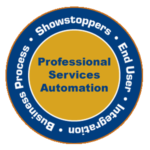Choosing the Best PSA Tool for Your Needs
A PSA tool is a great way to bring efficiency to project-based organizations. If you have decided that you want to implement a PSA tool but you’re not sure which is the best one for your organization or business, here are a few things to consider.

The first step is to determine the requirements you will need from the tool. Your requirements should be specific and measurable and prioritized according to need such as critical, standard, or simply desired. By establishing requirements that are measurable, you will have a baseline against which to objectively compare PSA solutions to find a best fit.
To determine PSA tool requirements, here are a few questions to ask yourself:
- What critical reports will the system need to compute or produce?
- What is project management methodology? Agile? Waterfall? Other?
- How do you need to track and report on project progress?
Think of Your End User
End-users interacting with your PSA solution have varying needs based on their roles in the organization. Think about what each type of user may need from the solution to do their daily job. Project Managers will need access to project progress and easily adjust planning for project delivery. Time and Expense users will need the ability to enter timesheets quickly and accurately, ensuring they have access to the right projects at the right time. Executives will need dashboards to monitor important business metrics. In today’s world, mobile access is also a consideration. What can the system support when people are working exclusively with their tablet or smartphone to help complete activities when their laptop or desktop is not available?
Think of Your Business Process
Each organization has a set, or should have a set, of defined processes to clarify roles, responsibilities, and expectations as projects are scoped, started, executed, and closed. Take the time to document your business model in terms of key process areas such as Opportunity to Project handoff, Project Lifecycle processes, Resource Scheduling and Skills management, Financial Management of engagements, and more. Each key process will highlight specific needs a PSA Tool will need to support and to establish approaches to enforce compliance and accountability.
Identify Showstoppers and Integration Needs
Now go through the list of requirements and identify any that will prevent adoption such as platform limitations, security controls and protocols, critical functionality for the organization, etc. By identifying showstoppers immediately, you’ll be able to down select your potential vendor list quicker. Many of the critical showstoppers will tend to fall into reporting, accessibility, usability, so you need to know what is critical and what is not.
And finally, what are the integration possibilities with the tool? You may want to integrate the PSA tool with various other systems to keep data consistent and accurate while streamlining workflows and user administrative efforts.
Do Your Research
When you’re finally at the point where you want to choose a vendor, do your research by taking a look at analyst and industry reports. A decent starting place is the Wikipedia page “Comparison of PSA systems.” It has PSA vendor information about basic features, licensing, types of platforms, and the dates of when different tools were first released so that you can get an idea of maturity level. The page also highlights which PSA tools are specifically defined for certain types of organizations.
Whatever tool you choose, make sure to get a few opinions. It’s a big decision and you want to make sure you choose the right one for your organization. A PSA tool is an investment and it will be a big part of the success of your company moving forward. For more information on how to choose PSA tools view the TOP Step webinar “Under the Hood: PSA Operations at a Glance.”
